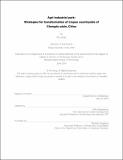| dc.contributor.advisor | Miho Mazereeuw. | en_US |
| dc.contributor.author | Hong, Fei, S.M. Massachusetts Institute of Technology | en_US |
| dc.contributor.other | Massachusetts Institute of Technology. Department of Architecture. | en_US |
| dc.coverage.spatial | a-cc--- | en_US |
| dc.date.accessioned | 2014-11-04T20:28:30Z | |
| dc.date.available | 2014-11-04T20:28:30Z | |
| dc.date.issued | 2014 | en_US |
| dc.identifier.uri | http://hdl.handle.net/1721.1/91300 | |
| dc.description | Thesis: S.M., Massachusetts Institute of Technology, Department of Architecture, June 2014. | en_US |
| dc.description | This electronic version was submitted by the student author. The certified thesis is available in the Institute Archives and Special Collections. | en_US |
| dc.description | Cataloged from student-submitted PDF version of thesis. "June 2014." | en_US |
| dc.description | Includes bibliographical references (pages 82-83). | en_US |
| dc.description.abstract | After 30 years' fast economic growth and urbanization, the gap between city and village has become one of the biggest challenges of today's China. Large countryside area with distinctive landscape is dying because of poor living conditions and fewer job opportunities. At the same time, the frenzy of Industry Park and Office Park developments, which started in the 1990s, is taking vast farmland from countryside, especially in peri-urban area. The process of land acquisition removes all the famers and existing agriculture elements. Millions of farmers lose their land for life support every year in China. Linpan is a typical agriculture landscape in Sichuan Plain, China. It is charactered by scattered residential settlements enclosed by trees and bamboos distributed in large farmland area with dense irrigation system, which has a history of two thousand years. When Chengdu quickly becomes one of the largest industry cities of West China after 1980s, more than 100km² of Linpan area has been transferred to various of industry parks and office parks and the number is still growing. By taking a typical linpan land as a testing site, the thesis proposes a mutual-beneficial cooperation mode of agriculture and selected industry development. New programs are plugged in within minimum effect on agriculture system. Certain degree of agriculture is maintained till the end of development process. When factories and offices enjoy the benefits from the in-site agriculture production and beauty of landscape, new possiblities of Chinese New Countryside is appearing. | en_US |
| dc.description.statementofresponsibility | by Fei Hong. | en_US |
| dc.format.extent | 83 pages | en_US |
| dc.language.iso | eng | en_US |
| dc.publisher | Massachusetts Institute of Technology | en_US |
| dc.rights | M.I.T. theses are protected by copyright. They may be viewed from this source for any purpose, but reproduction or distribution in any format is prohibited without written permission. See provided URL for inquiries about permission. | en_US |
| dc.rights.uri | http://dspace.mit.edu/handle/1721.1/7582 | en_US |
| dc.subject | Architecture. | en_US |
| dc.title | Agri-industrial park : strategies for transformation of Linpan countryside of Chengdu plain, China | en_US |
| dc.title.alternative | Strategies for transformation of Linpan countryside of Chengdu plain, China | en_US |
| dc.type | Thesis | en_US |
| dc.description.degree | S.M. | en_US |
| dc.contributor.department | Massachusetts Institute of Technology. Department of Architecture | |
| dc.identifier.oclc | 893485011 | en_US |
